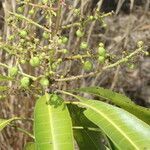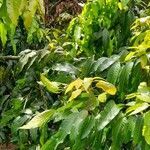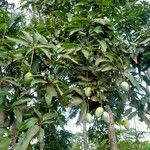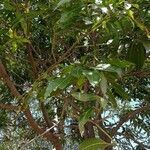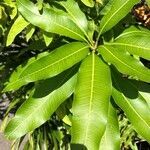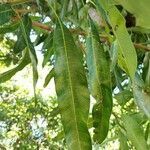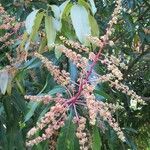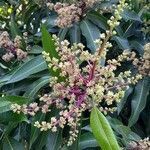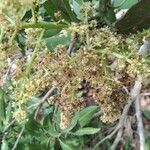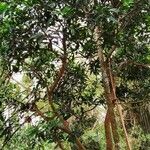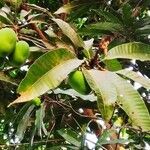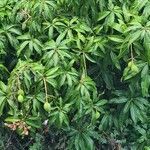Tree 10-30(-45) m high and up to 60(-120) cm ø. Bark grey, greyish brown, longitudinally fissured. Leaves subcoriaceous, chartaceous, or membranaceous, variable in size and shape, usually lanceolate, elliptic to narrowly elliptic, 10-30 by 2-9½ cm, glabrous; base acute or cuneate; apex acute to acuminate; nerves 12-30 pairs, elevated on both surfaces; veins reticulate, distinct on both surfaces; petiole 1½-7½ cm, convex beneath, grooved or flat above. Panicles terminal, sometimes also in the uppermost leaf axil, pyramidal, 6-44 cm long, tomentose; lateral branches up to 15 cm, densely flowered; floral bracts ovate-oblong, 3-5 mm long; pedicels c. 1 mm. Flowers usually greenish yellow or pale cream. Calyx 5-lobed, lobes ovate-oblong or elliptic, densely puberulous on both surfaces especially on the outside. Petals 5, elliptic, elliptic-oblong, or ovate-oblong, 3-5 by 1½-2mm, ½-⅔ the length of petals, confluent often at the lower half. Disk short-cupular, 1-1½ mm high, 1½ mm ø, 5-lobed or-notched, papillate. Stamens 5, 1 (rarely 2) fertile, 2-3 mm; filaments free; anthers ovoid, c. ⅔ mm long; staminodes l-1½ mm. Ovary obliquely ovoid or subglobose, 1-1½ mm ø; style excentric, 1½-2 mm. Sterile pistil in ♂ obscure or absent. Drupe (fresh) (OCHSE & BAKH. l.c.) very variable as to shape, size, and colour, usually ovoid-oblong, very unequal-sided, 4-25 by 1½-10 cm, yellowish green, yellow, or red in many shades when ripe; flesh yellow or orange coloured, juicy, savoury; stone rather thick, with a fibrous coat, very hard. Seed not labyrinthine.
Tree 10–40 m. high, with dense dome-shaped crown; trunk stout, with greyish-brown fissured bark; branchlets rather stout.. Leaves glabrous; petiole 2–4.5 cm. long, striate; lamina usually reddish in colour, later turning dark shiny green, oblong or oblong-lanceolate, 8–40 cm. long, 2–10 cm. broad, obtuse to acute or acuminate at the apex, cuneate at the base, coriaceous; midrib prominent on both sides but mainly beneath; lateral nerves and reticulation raised.. Inflorescence a widely branched terminal panicle 10–60 cm. long, branches often tinged red, pubescent or puberulous; pedicels 2–4 mm. long.. Sepals 5, 2–2.5 mm. long, 1–1.5 mm. broad, green with whitish margin or yellowish green, hairy outside.. Petals 5, 3–5 mm. long, 1–1.5 mm. broad, cream later becoming pinkish, with 3–5 darker yellow ridges on the inner surface.. Stamens l(–2) fertile with filament 4–5 mm. long; anthers pink but turning purple at anthesis; staminodes 3(–4), very short.. Disk ± 2 mm. high, 5-lobed.. Pistil abortive in ♂; in hermaphrodite flowers ovary depressed-globose, 1.5 mm. long; style ± 2 mm. long, lateral, opposite the fertile stamen.. Drupe variable in size and shape, from rounded to ovoid-oblong and sometimes laterally depressed, 8–30 cm. long, 7–12 cm. broad, green to yellow or red.
An erect, branched evergreen tree. It can grow to 10-40 m high and is long lived. (Trees grown by vegetative means are smaller and more compact.) Trees spread to 15 m across. It has strong deep roots. The trunk is thick. The bark is greyish-brown. The leaves are simple and shaped like a spear. Some kinds of mangoes have leaves with a wavy edge. They can be 10-30 cm long and 2-10 cm wide. They are arranged in spirals. The leaf stalk is 1-10 cm long and flattened. Leaves are often brightly coloured and brownish-red when young. These tender leaves which are produced in flushes become stiff and dark-green when mature. The flower stalks are at the ends of branches. They are 10-50 cm long and branching. Up to 6,000 flowers can occur on a stalk. Most of these are male and between 1 and 35 % have both male and female flower parts. Fruit are green, yellow or red and 2.5 to 30 cm long. The fruit hang down on long stalks. The outside layer of the seed is hard and fibrous and there is one seed inside. Several embryos can develop from one seed by asexual reproduction. The fruit shape and colour vary as well as the amount of fibre and the flavour. India has many varieties and they cannot tolerate humidity.
Tree to 20 m high in Australia. Branchlets glabrescent. Leaves alternate or whorled, simple; lamina oblong-elliptic to oblong-lanceolate (± narrowly so) or narrowly elliptic-lanceolate, mostly 10–30 cm long, 2–7 cm wide, acute base, acuminate, acute or obtuse apex, subcoriaceous to coriaceous, glossy green, glabrous, aromatic, secondary veins mostly 15–25 pairs; petiole 2–6 cm long. Panicles tomentose to almost glabrous; bracts ovate or triangular, 2–4.5 mm long; pedicels 1–1.5 mm long. Flowers to c. 5 mm diam., fragrant. Sepals 5, narrowly ovate to ovate, 1.5–3 mm long. Petals 5, oblong-ovate to oblong-obovate or narrowly ovate, 2.5–5 mm long, white (often tinged purple), cream, yellow-cream, pinkish or purplish, with 3–5 ridges inside near base. Disc extra-staminal, thick, broadly 5-lobed, papillose. Fertile stamen usually 1; anther c. 0.8 mm long; filament 1.8–2.2 mm long. Staminodes minute or to 1 mm. Ovary obliquely ovoid to depressed-globular; style eccentric, 1.5–2 mm long. Pistillode in males minute. Drupe obliquely ovoid, mostly 10–15 (–25) cm long, ripening from green to yellow to orange or reddish; exocarp coriaceous; mesocarp fleshy, succulent; endocarp fibrous.
Trees, 10-20 m tall; branchlets brown, glabrous. Petiole 2-6 cm, grooved apically, inflated basally; leaf blade oblong to oblong-lanceolate, 12-30 × 3.5-6.5 cm, leathery, deep green adaxially, light green abaxially, glabrous on both sides, base cuneate to obtuse, margin entire, undulate, apex acute to long acuminate, lateral veins 20-25 pairs, midrib prominent on both sides, reticulate venation obscure. Inflorescence paniculate, terminal, 20-35 cm, glabrous to tomentose-pilose; bracts ca. 1.5 mm, lanceolate pubescent. Pedicels 1.5-3 mm, articulate. Sepals ovate-lanceolate, 2.5-3 × ca. 1.5 mm, glabrous to pubescent, acuminate. Petals light yellow with prominent red tree-shaped pattern adaxially, oblong or oblong-lanceolate, 3.5-4 × ca. 1.5 mm, glabrous, recurved at anthesis. Fertile stamen 1, ca. 2.5 mm, with ovate anther; staminodes 4, 0.7-1 mm. Disk inflated, fleshy, 5-lobed. Ovary oblique, ovate, ca. 1.5 mm in diam. at anthesis; style ca. 2.5 mm, eccentric. Drupe oblong to subreniform, greenish yellow to red, 5-10 × 3-4.5 cm; fleshy mesocarp bright yellow; endocarp ± compressed. Fl. Mar-Apr, fr. May-Jul.
Tree or shrub, 5-20 m high; branchlets fulvous-puberulous, glabrescent when old. Leaves petiolate, striate, glabrous, coriaceous, concolorous, green, oblong or oblong-lanceolate; midrib prominent on both sides, lateral nerves and reticulation raised. Flowers: male and female flowers on same panicle. Sepals 5, green with whitish margins, sericeous-pilose outside. Petals 5, whitish. Stamens 1(2) fertile, filaments long; staminodes 3(4), short. Disc thick. Ovary depressed-globose; styles lateral, opposite to fertile stamen. Fruit a drupe.
Leaves glabrous; petiole 2–4·5 cm. long, striate; lamina concolorous, green, (9) 10–33 × (2) 2·5–8 cm., oblong or oblong-lanceolate, obtuse to acute or acuminate at the apex, cuneate at the base, coriaceous; midrib prominent on both sides, mainly below, lateral nerves and reticulation raised.
Ovary 1·5 mm. long, depressed-globose; style c. 2 mm. long, lateral, opposite to the fertile stamen.
Male and hermaphrodite flowers in the same panicle; pedicels 2–4 mm. long, puberulous.
Sepals 5, green with whitish margin, 2–2·5 × 1–1·5 mm., sericeous-pilose outside.
Stamens 1(2) fertile with filament 4–5 mm. long; staminodes 3(4), very short.
A tree 10–30 m. high; branchlets fulvous-puberulous, glabrescent when older.
Panicle up to 30 cm. long, pyramidal, with the axis tomentose or puberulous.
Widely cultivated but here and there well established in secondary bush.
Petals 5, whitish with the 3–7 nerves reddish, 3–5 × 1–1·5 cm.
Drupe very variable in shape and size, 8–25 × 7–10 cm.
Disk c. 2 mm. high, thick.
